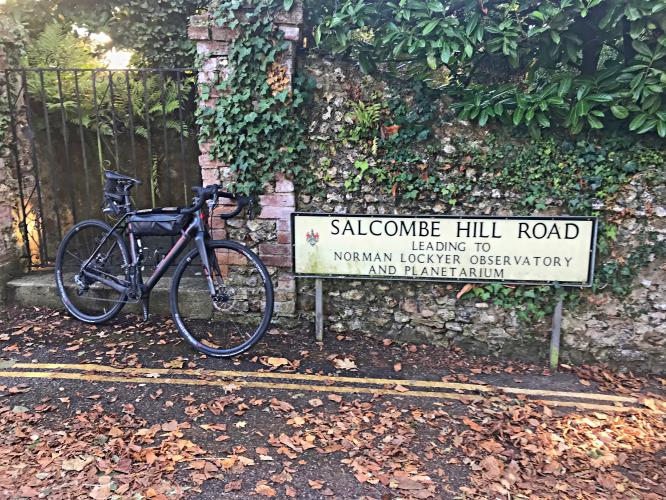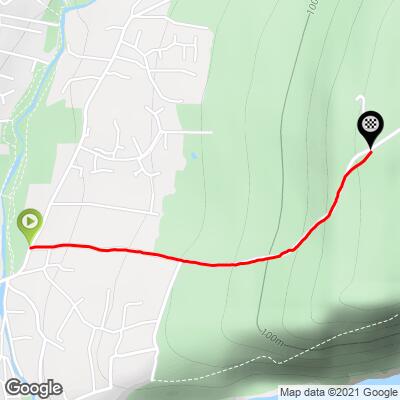![]()
Where it all begins . . .
This is a stout climb in site of the English Channel to our right as we climb 1.2 kilometers at 13% average grade. This one is no slouch with 500 meters at an average 17% from 650 to 1100 meters.
![]()
The observatory is staffed by volunteers, and is regularly open to the public on published afternoons and evenings.” Wikipedia - Norman Lockyer Observatory
![]()
Photo - Christine Matthews
Start in the sizeable originally fishing village of Sidmouth and climb into East Devon Area of Outstanding Natural Beauty to the exit of the Norman Lockyer Observatory.
![]()
The first 400 meters are through a residential area.
![]()
The last 500 meters is bordered by trees and through forest.
![]()
Steepest ½ kilometer begins at 600m (17%)
![]()
This is a short but very steep climb in southern England, a stone’s throw from the English Channel. The climb enters the East Devon Area of Outstanding Natural Beauty a couple hundred meters from its start:
“East Devon Area of Outstanding Natural Beauty (AONB) covers over 100 square miles (260 km2) of the East Devon countryside (England).
This countryside includes eighteen miles (29 km) of Heritage coastline. The designated area covers: twenty-nine parishes and borders the coastal towns of Exmouth, Seaton and Sidmouth but includes the entire resort of Budleigh Salterton.
East Devon has two AONBs within its catchment area which includes the Blackdown Hills (designated 1991) and East Devon AONB (designated 1963), both AONBs make up over 66% of the district.
East Devon AONB Partnership is a joint initiative funded by Defra (Department for Environment, Food and Rural Affairs), East Devon District Council and Devon County Council. Through ventures such as community projects and project grants East Devon AONB Partnership helps to conserve and manage the East Devon AONB.” Wikipedia - East Deveon AONB
The climb begins in Sidmouth (population 12,569):
“Sidmouth appeared in the Domesday Book as Sedemuda, meaning "mouth of the Sid". Like many such settlements, it was originally a fishing village. Although attempts have been made to construct a harbour, none has succeeded. A lack of shelter in the bay prevented growth as a port.
Sidmouth remained a village until the fashion for coastal resorts grew in the Georgian and Victorian periods of the 18th and 19th centuries. A number of Georgian and Regency buildings still remain. In 1819, George III's son Edward, Duke of Kent, his wife, and baby daughter (the future Queen Victoria) came to stay at Woolbrook Glen for a few weeks. In less than a month he had died from an illness. The house later became the Royal Glen Hotel; a plaque on an exterior wall records the visit. In 1874, Sidmouth was connected to the railway network by a branch line from Sidmouth Junction, which called at Ottery St Mary and Tipton St John. This was dismantled in 1967 as a result of the Beeching Axe.
In 2008, a Canadian millionaire, Keith Owen, who had been on holiday in the town and planned to retire there, bequeathed the community's civic society, the Sid Vale Association, about £2.3 million upon learning that he had only weeks to live due to lung cancer. The bequest was used as a capital fund to generate an annual interest dividend of around £120,000 for community projects.” Wikipedia - Sidmouth
Just past the completion of the climb is the Norman Lockyer Observatory:
“The observatory was founded by Joseph Norman Lockyer in 1912 when he retired to Sidmouth[3] following the closure of the South Kensington Observatory, of which Lockyer was Director. Originally known as Hill Observatory, the observatory was renamed Norman Lockyer Observatory after his death in 1920. Lady Lockyer took a strong interest and made gifts to the observatory. She was elected to the Royal Astronomical Society in 1923.
The Observatory's historic instruments are associated with Lockyer's pioneering work on star temperature which led to theories of stellar evolution and the foundation of astrophysics.
The facility was operated by the University of Exeter between 1948 and 1984. In 1984 East Devon District Council became the owner/trustee of the observatory and after a period of renovation leased it to Norman Lockyer Observatory Society (NLOS) in 1995. An exhibition area and 60-seat planetarium was added in 1996 and a 100-seat convention center for lectures and academic conferences added in 2005. The Connaught Dome, which incorporates 'Lockyer Technology Centre' (the observatory’s radio astronomy facility), was opened in 2012.
Roadcyclinguk.com:
“Slightly confusingly, this Salcombe Hill isn’t in the famous town of Salcombe itself, but climbs out of the seaside town of Sidmouth instead towards Salcombe Regis. Although, it’s less of a climb and more a wall in our opinion.
The start of the climb belies the coming difficulty, registering as a false flat for the first 200m. That’s the case, even though the total climb length is only 1.2km and it averages a leg-burning 13 per cent.
As you rise up the road that curves left to follow the southerly coastline, the gradient only gets tougher, gradually getting steeper to the tune of 20 per cent. It’s a power climb, this one, and only eases slightly as you near the summit – but it’s not enough to take any respite, so it’s full gas to the top.” More

 We've partnered with Sherpa-Map.com to bring you the best route planning tool. With a PRO Membership you can use this climb as a reference when creating your route.
We've partnered with Sherpa-Map.com to bring you the best route planning tool. With a PRO Membership you can use this climb as a reference when creating your route. 

